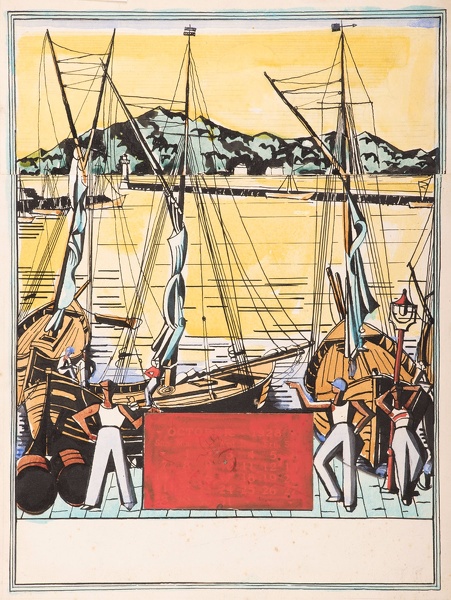
£690
Calendar Design. October, 1928
Framed (ref: 9078)
Watercolour, pen and pencil
Tags: Karl Hagedorn pen and ink pencil watercolour landscape maritime

Tags: Karl Hagedorn pen and ink pencil watercolour landscape maritime
Provenance: The Artist's Estate
In the history of Modern British art Karl Hagedorn presents a conundrum. If one mentions his name to most people it draws little recognition, unless they are an art dealer or an art historian – although, even then, it will more-often-than-not draw a blank. Perhaps the most intriguing response to his name was itself a question: ‘Was he not the illegitimate son of the Kaiser?’ In a way, this question (whether or not the answer is as sensational as it might be) identifies one of the central problems with Hagedorn: everything about him and his work seems not to fit with the British context in which he found himself in the early twentieth-century. Aside from the question of his possible paternity, to be from Germany whilst living in Britain between 1914-18 would not have made for an easy life of welcoming acceptance, although he did indeed, volunteer to serve on the side of his adopted country against his country of birth. But even prior to the First World War, the radically modern character of his art further identified him as an alien influence, an outsider bringing with him strange ideas, jarring shapes and contrasting colours brought from the continent. Reviewers at the time professed bafflement at Hagedorn’s ‘cubist puzzles’ and referred to him as being like the Fauves (or ‘wild beasts’) who ‘had a hatred of what was tame and conventional’, as if to suggest that being tame and conventional was somehow a virtue. Hagedorn’s “rhythmical expressions in line and colour” are some of the earliest and boldest examples of Post-Impressionist work produced in this country and yet he has become a footnote in art history.
In many ways Hagedorn’s career both reflects and is part of wider tendencies in art, for example, in his retreat from radical modernism in the years following the First World War, which reflects the wider ‘Return to Order’ manifested in the work of artists such as Pablo Picasso, Andre Derain and Gino Severini on the continent, and artists such as Duncan Grant, Vanessa Bell and Edward Wadsworth in Britain. His watercolours of the 1920s encapsulate the search for solace in the landscape that appears in the work of so many others of his generation. These works have a distinctive clarity and call to mind Paul Nash’s question of whether it was possible to ‘Go Modern and Be British’. As an outsider, Hagedorn as not weighed down by such a sense of tradition. In the same period, he was also designing eye-catching posters that patriotically called on their viewers to ‘Buy British’ applying the lessons of European modernism to commercial advertising for the Empire Marketing Board. Hagedorn’s work deserves to be better known and for its place in the story of Modern British art to be properly recognised.
We are grateful to Simon Martin, Director Pallant House Gallery, Chichester